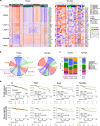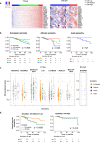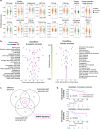Ancestry-associated transcriptomic profiles of breast cancer in patients of African, Arab, and European ancestry
- PMID: 33558495
- PMCID: PMC7870839
- DOI: 10.1038/s41523-021-00215-x
Ancestry-associated transcriptomic profiles of breast cancer in patients of African, Arab, and European ancestry
Abstract
Breast cancer largely dominates the global cancer burden statistics; however, there are striking disparities in mortality rates across countries. While socioeconomic factors contribute to population-based differences in mortality, they do not fully explain disparity among women of African ancestry (AA) and Arab ancestry (ArA) compared to women of European ancestry (EA). In this study, we sought to identify molecular differences that could provide insight into the biology of ancestry-associated disparities in clinical outcomes. We applied a unique approach that combines the use of curated survival data from The Cancer Genome Atlas (TCGA) Pan-Cancer clinical data resource, improved single-nucleotide polymorphism-based inferred ancestry assignment, and a novel breast cancer subtype classification to interrogate the TCGA and a local Arab breast cancer dataset. We observed an enrichment of BasalMyo tumors in AA patients (38 vs 16.5% in EA, p = 1.30E - 10), associated with a significant worse overall (hazard ratio (HR) = 2.39, p = 0.02) and disease-specific survival (HR = 2.57, p = 0.03). Gene set enrichment analysis of BasalMyo AA and EA samples revealed differences in the abundance of T-regulatory and T-helper type 2 cells, and enrichment of cancer-related pathways with prognostic implications (AA: PI3K-Akt-mTOR and ErbB signaling; EA: EGF, estrogen-dependent and DNA repair signaling). Strikingly, AMPK signaling was associated with opposing prognostic connotation (AA: 10-year HR = 2.79, EA: 10-year HR = 0.34). Analysis of ArA patients suggests enrichment of BasalMyo tumors with a trend for differential enrichment of T-regulatory cells and AMPK signaling. Together, our findings suggest that the disparity in the clinical outcome of AA breast cancer patients is likely related to differences in cancer-related and microenvironmental features.
Conflict of interest statement
The authors declare no competing interests.
Figures





Similar articles
-
Molecular profiling of a real-world breast cancer cohort with genetically inferred ancestries reveals actionable tumor biology differences between European ancestry and African ancestry patient populations.Breast Cancer Res. 2023 May 25;25(1):58. doi: 10.1186/s13058-023-01627-2. Breast Cancer Res. 2023. PMID: 37231433 Free PMC article.
-
Differences in gene-expression profiles in breast cancer between African and European-ancestry women.Carcinogenesis. 2020 Jul 14;41(7):887-893. doi: 10.1093/carcin/bgaa035. Carcinogenesis. 2020. PMID: 32267939 Free PMC article.
-
Variants of estrogen-related genes and breast cancer risk in European and African American women.Endocr Relat Cancer. 2014;21(6):853-64. doi: 10.1530/ERC-14-0250. Epub 2014 Sep 16. Endocr Relat Cancer. 2014. PMID: 25228414 Free PMC article.
-
Genomic, epigenomic, and transcriptomic signatures of prostate cancer between African American and European American patients.Front Oncol. 2023 Feb 28;13:1079037. doi: 10.3389/fonc.2023.1079037. eCollection 2023. Front Oncol. 2023. PMID: 36937425 Free PMC article. Review.
-
Racial Disparities in Triple Negative Breast Cancer: A Review of the Role of Biologic and Non-biologic Factors.Front Public Health. 2020 Dec 22;8:576964. doi: 10.3389/fpubh.2020.576964. eCollection 2020. Front Public Health. 2020. PMID: 33415093 Free PMC article. Review.
Cited by
-
Health Disparities among Patients with Cancer Who Received Molecular Testing for Biomarker-Directed Therapy.Cancer Res Commun. 2024 Oct 1;4(10):2598-2609. doi: 10.1158/2767-9764.CRC-24-0321. Cancer Res Commun. 2024. PMID: 39172022 Free PMC article.
-
A Biochemical View on Intermittent Fasting's Effects on Human Physiology-Not Always a Beneficial Strategy.Biology (Basel). 2025 Jun 9;14(6):669. doi: 10.3390/biology14060669. Biology (Basel). 2025. PMID: 40563920 Free PMC article. Review.
-
Bidirectional Regulatory Cross-Talk between Cell Context and Genomic Aberrations Shapes Breast Tumorigenesis.Mol Cancer Res. 2021 Nov;19(11):1802-1817. doi: 10.1158/1541-7786.MCR-21-0163. Epub 2021 Jul 20. Mol Cancer Res. 2021. PMID: 34285086 Free PMC article.
-
Immune-related 3-lncRNA signature with prognostic connotation in a multi-cancer setting.J Transl Med. 2022 Sep 30;20(1):442. doi: 10.1186/s12967-022-03654-7. J Transl Med. 2022. PMID: 36180904 Free PMC article.
-
Genetic Ancestry Inference and Its Application for the Genetic Mapping of Human Diseases.Int J Mol Sci. 2021 Jun 28;22(13):6962. doi: 10.3390/ijms22136962. Int J Mol Sci. 2021. PMID: 34203440 Free PMC article. Review.
References
Grants and funding
LinkOut - more resources
Full Text Sources
Other Literature Sources
Research Materials
Miscellaneous

